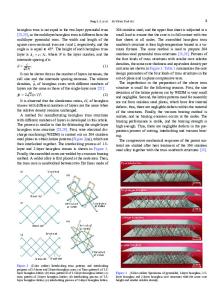C/C–SiC sandwich structures manufactured via liquid silicon infiltration
- PDF / 656,270 Bytes
- 11 Pages / 584.957 x 782.986 pts Page_size
- 34 Downloads / 935 Views
es Klett University of Stuttgart, Institute of Aircraft Design, Stuttgart, Germany (Received 15 February 2017; accepted 8 May 2017)
In a new design approach, C/C–SiC sandwich structures have been realized via liquid silicon infiltration and in situ joining methods. In the first process step, the carbon fiber reinforced polymer preforms for the planar skin plates as well as for the core structures were manufactured via warm pressing and autoclave technique, using C fiber fabrics preimpregnated with phenolic resin. Thereby, two types of C/C–SiC core structures were used: foldcore and grid core. In the second process step, the sandwich components were pyrolyzed separately, leading to porous C/C preforms and subsequently joined to a C/C sandwich structure, using an adhesive. In the last process step, the C/C structure was infiltrated with molten Si, and the SiC matrix was built up by a chemical reaction of Si and C, leading to a permanently joined C/C–SiC sandwich structure. For mechanical characterization, sandwich specimens were manufactured and tested in 4 point bending.
I. INTRODUCTION
Sandwich structures are characterized by thin walled face sheets or skins, bonded to a lightweight core, placed or sandwiched in-between the skins. The fundamental concept of a sandwich design is based on the separation of functions. Thereby, the skins are responsible for taking over the in-plane tensile and compressive stresses, whereas the core has to carry the shear stresses. By selecting high strength and modulus materials, like carbon fiber reinforced polymer (CFRP), for the skins, and highly porous, lightweight cores, like honeycombtype paper structures, very efficient and therefore extremely lightweight panel structures can be realized. Sandwich structures are used in various application areas, especially in aerospace, but are also very common in transportation and automotive, ship building, architecture, building and construction industries as well as in furniture industry, and are well known in daily life from corrugated board boxes in packaging. Sandwich structures based on skins made of glass or C fiber reinforced polymers and on cores like polymer foam, aramid paper honeycomb structures, or grid cores (GCs) based on bi- or multidirectional CFRP webs1 are well known. For high temperature applications, e.g., in sintering furnaces, sandwich structures made of monolithic ceramics,2,3 like alumina and cordierite, are enabling charging carriers with high loading capacities and low Contributing Editor: Nahum Travitzky a) Address all correspondence to this author. e-mail: [email protected] DOI: 10.1557/jmr.2017.208
masses, leading to faster cycles for heating up and cooling down, reduced energy consumption, and more economic production processes. Typical applications for SiC based sandwich structures are highly rigid mirrors in aerospace. However, usually no separate cores are used, but ribbed structures are machined out of massive preforms and joined together, leading to hollow SiC structures with the ribs acting as webs.4 T
Data Loading...









